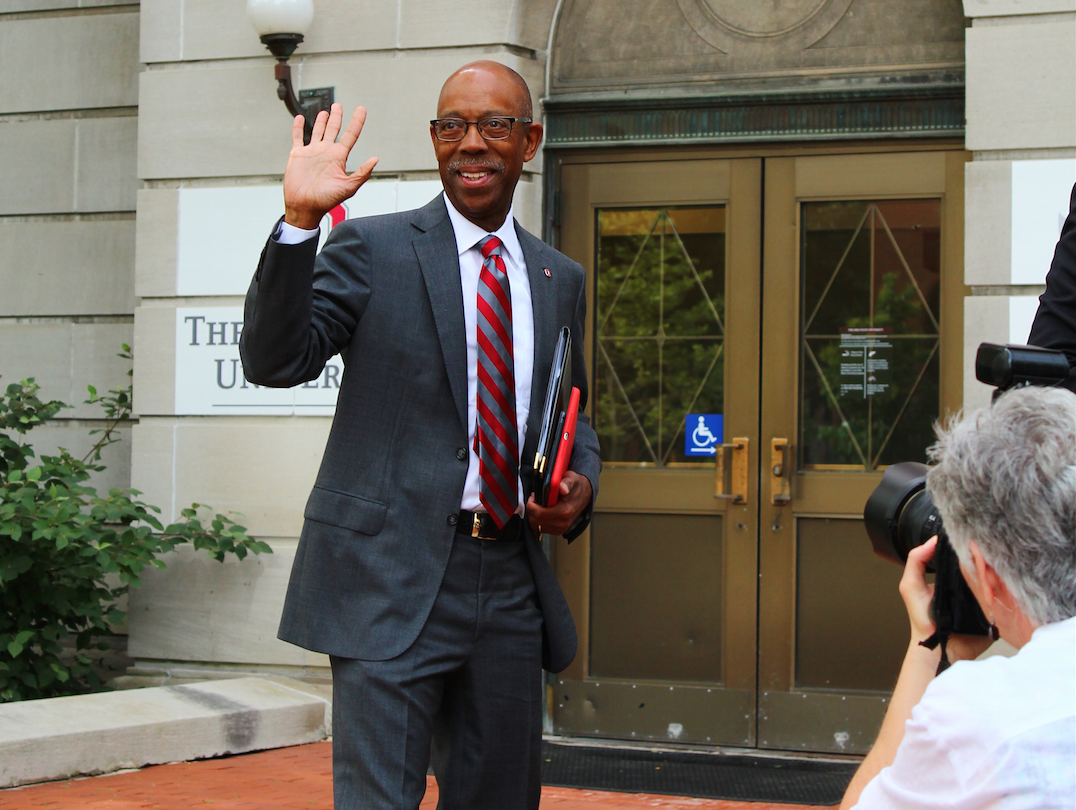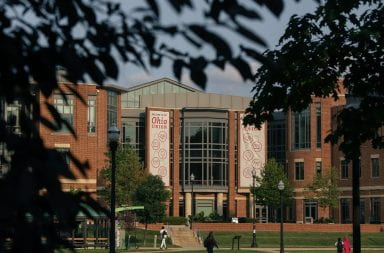
President Michael V. Drake walks into Bricker Hall, starting his first day as the university’s 15th president on June 30, 2014. Credit: Mark Batke | Former Photo Editor
When University President Michael V. Drake announced his retirement in November, he said he and the university were in a good position to pass the baton to the next leader. Then COVID-19 happened.
In an interview with The Lantern Thursday, Drake said the timeline on his retirement is flexible due to the COVID-19 pandemic and that he will offer support to the next president in any way he can.
“Of course we’re not gonna get to the line and drop the baton,” Drake said. “To the extent that the 16th president is identified and ready and whatever, then I will pass the baton and to help them move forward, and will that precisely be the day that we had planned? Maybe not, and we’ll learn about that as these next couple of months go on.”
Drake has served nearly six years as university president and originally planned to step down following the end of this academic year to fill a faculty position.
But since then, the university has transitioned classes online, closed campus following spring break, moved summer classes online and canceled events through July 6. And there is still uncertainty about what fall semester will look like.
Closures amid the COVID-19 pandemic aren’t the only challenges Drake has faced during his presidency.
Drake joined the university in 2014 during an Ohio State Marching Band scandal, following an investigation into the band. The investigation found that there were “some serious cultural issues and an environment conducive to sexual harassment,” the report stated, and band director Jonathan Waters was fired.
Drake’s retirement also comes as the university faces lawsuits from victims of former university physician Richard Strauss, who an independent investigation found abused more than 177 students and student-athletes during his 1978-98 tenure. The investigation also found that Ohio State failed to act on the abuse at the time. Strauss died by suicide in 2005.
After more than a year in mediation, Ohio State settled 11 of 18 suits in March, and Monday a federal judge announced a partial lift on the mediation stay for remaining survivors to allow them to pursue litigation.
In August 2017, Ohio State launched an investigation into former head football coach Urban Meyer following the firing of former wide receivers coach Zach Smith in light of domestic violence allegations.
Drake said that in handling the challenges that have emerged during his tenure, the university’s approach has been to deal with them in a “straightforward and clear fashion.”
“These are complicated communities, complicated jobs. Things happen and it’s our job really to kind of understand, roll with them and move forward and that’s what we try to do,” he said.
Drake said that despite the challenges the university has faced in the past six years, he is proud of the positive things, including producing three Rhodes scholars, increasing the graduation rate and campus diversity and setting records in fundraising and faculty awards.
During Drake’s presidency, Ohio State implemented a tuition freeze for in-state students for the first time in 40 years and has committed more than $150 million in additional need-based aid since 2015, according to the press release announcing Drake’s retirement.
The university also began its Digital Flagship partnership with Apple in fall 2018, a universitywide digital learning initiative to support educational innovation and economic development that includes giving first-year students iPads, according to the Digital Flagship website.
“Our position among universities is that we are more engaged, more influential, more of a trendsetter among universities here in this country than we’ve ever been by a lot,” Drake said. “And a part of our being able to get through this semester well, with all of the things that have happened, is just how strong we’ve been.”
Although the next president has yet to be chosen, Drake said he would advise that person to keep in touch with the people within the community.
“I would hope that that person can have one eye on our excellence and all those things that make us better,” Drake said. “And at the same time have an eye on those in our community who are the most vulnerable and who benefit the most from our support and protection and to keep both of those in front of mind at all times to make us the best place we can be and most human and connected and supportive place we can be and I think that should be done all day every day.”


